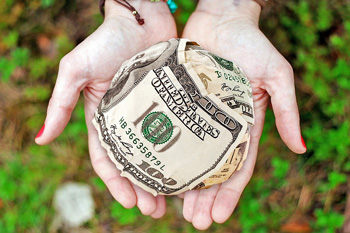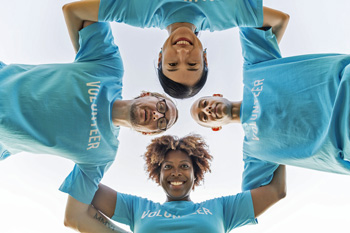Donating and Volunteering After a Disaster
- Get Prepared
- Emergencies
- Current: Donating and Volunteering After Disasters
Giving USA reports about $557 billion was donated to charities by Americans in 2023. Volunteering or sending donations such as clothes, water and other household items is a common reaction following a disaster. However, this actually can cause more problems for responders and individuals impacted by a disaster.
Donating and Volunteering Tips
Quick Tips
- Check on the legitimacy of a charitable organization before donating.
- Ask questions of people or organizations asking for donations.
- Train how to be a volunteer before a disaster strikes so you are prepared when the time comes.
- Volunteer through experienced organizations that work together with first responders.
- Remember to take care of yourself after disasters. Let your supervisors know that you need time for self-care.

Donating
Providing funding or cash donations through a relief organization is the most efficient way to help affected areas. For the best donation practices, follow some safety tips before sending money.
- Always perform a thorough check on a charitable organization before any money is donated. A few items to check for include: program information, a detailed organization mission and fiscal reports.
- Common scam attempts include using names similar to well-known charities. One word may be the only difference, so always double-check the name before sending money.
- If a charitable organization calls asking for donations, never hesitate to ask the caller questions about the charity, where the money is going and why the money is being raised. Hesitance in answering these questions could be cause of concern.
- Be cautious of crowdfunding and social media donation requests. Ask questions about where the money is going, why the money is being requested and always ask for a transaction invoice.
- Charitable donations payments should be completed on a bank card, credit card or a check. These payment methods are recorded on a bank statement balance, which will provide proof a transaction was completed.

Volunteering
The Corporation for National and Community Service reports more than 75 million Americans volunteered for 4.99 billion hours in 2023. Helping those affected by volunteering is a natural response to a disaster. However, if safety precautions are not followed, volunteers can create more trouble than assistance.
- The best time to become a volunteer is before a disaster occurs. This allows individuals to be properly trained. Look online to learn more about Indiana Voluntary Organizations Active in Disaster.
- Some organizations may have non-disaster opportunities to help too, such as installing smoke alarms or providing event assistance.
- Work through an organization that is familiar and works in tandem with first responders.
- Obtain an assignment from a volunteer organization prior to arriving on scene. This ensures that volunteers are documented and helps maintain a safe scene.
- When on-scene of the disaster, wear appropriate clothing based on assigned duties. In most cases, fully covered arms and legs, closed-toe shoes and clothing that allows for easy mobility is recommended.
- Always follow safety guidelines, procedures and rules. Organizations create these standards to provide optimal assistance and to keep everyone involved safe.
- Stay aware of the surroundings. If there are signs of potential safety dangers, immediately notify the proper authorities.
- Regularly monitor physical, mental and emotional health. If there are any symptoms of fatigue, emotional distress or illness, immediately notify the on-duty supervisors and request to be relieved.
Resources
Websites
- After the Disaster: How to Donate and Volunteer Responsibly, podcast episode 83
FEMA - Before Giving to a Charity
Federal Trade Commission - Indiana Voluntary Organizations Active in Disaster
Indiana VOAD
